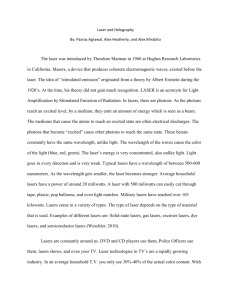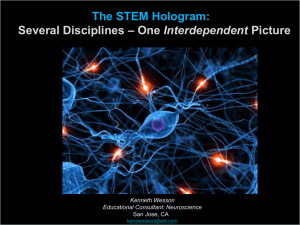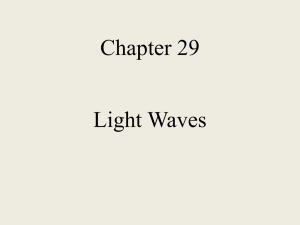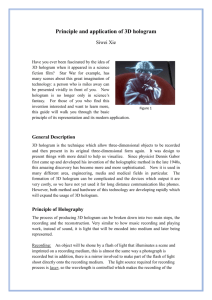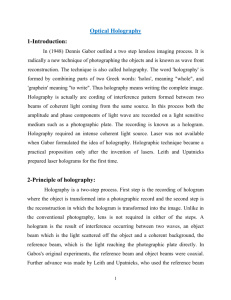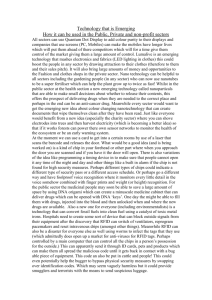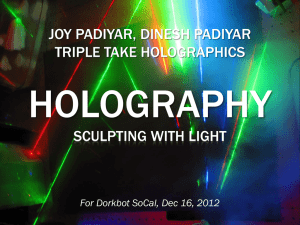201100003636
advertisement
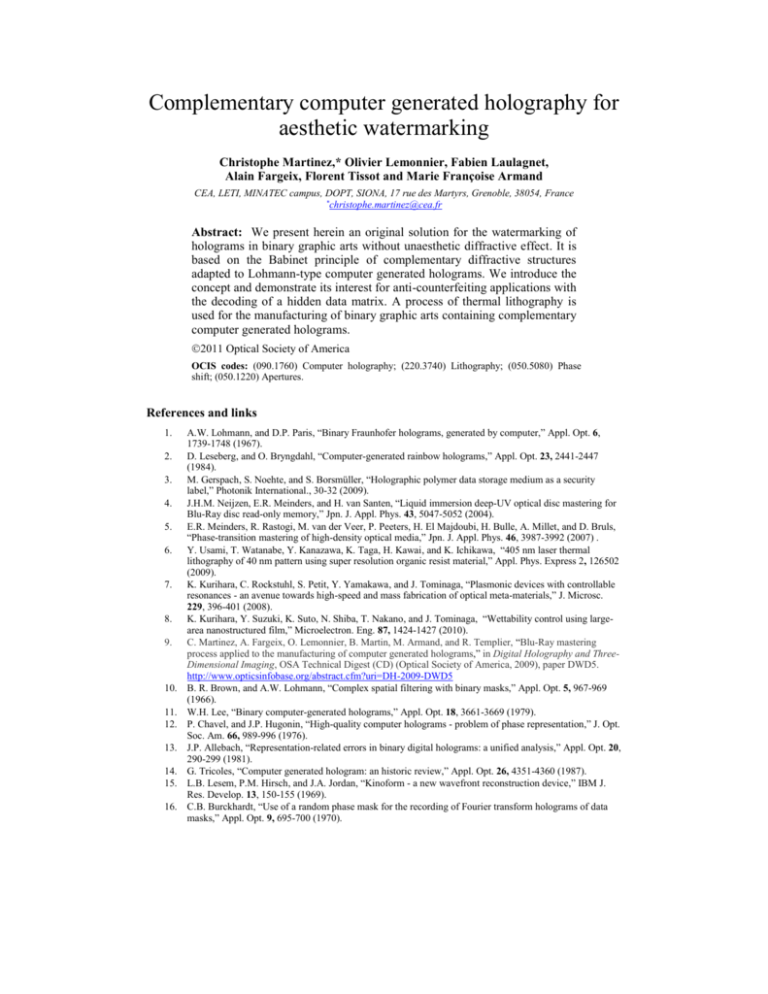
Complementary computer generated holography for aesthetic watermarking Christophe Martinez,* Olivier Lemonnier, Fabien Laulagnet, Alain Fargeix, Florent Tissot and Marie Françoise Armand CEA, LETI, MINATEC campus, DOPT, SIONA, 17 rue des Martyrs, Grenoble, 38054, France * christophe.martinez@cea.fr Abstract: We present herein an original solution for the watermarking of holograms in binary graphic arts without unaesthetic diffractive effect. It is based on the Babinet principle of complementary diffractive structures adapted to Lohmann-type computer generated holograms. We introduce the concept and demonstrate its interest for anti-counterfeiting applications with the decoding of a hidden data matrix. A process of thermal lithography is used for the manufacturing of binary graphic arts containing complementary computer generated holograms. 2011 Optical Society of America OCIS codes: (090.1760) Computer holography; (220.3740) Lithography; (050.5080) Phase shift; (050.1220) Apertures. References and links 1. 2. 3. 4. 5. 6. 7. 8. 9. 10. 11. 12. 13. 14. 15. 16. A.W. Lohmann, and D.P. Paris, “Binary Fraunhofer holograms, generated by computer,” Appl. Opt. 6, 1739-1748 (1967). D. Leseberg, and O. Bryngdahl, “Computer-generated rainbow holograms,” Appl. Opt. 23, 2441-2447 (1984). M. Gerspach, S. Noehte, and S. Borsmüller, “Holographic polymer data storage medium as a security label,” Photonik International., 30-32 (2009). J.H.M. Neijzen, E.R. Meinders, and H. van Santen, “Liquid immersion deep-UV optical disc mastering for Blu-Ray disc read-only memory,” Jpn. J. Appl. Phys. 43, 5047-5052 (2004). E.R. Meinders, R. Rastogi, M. van der Veer, P. Peeters, H. El Majdoubi, H. Bulle, A. Millet, and D. Bruls, “Phase-transition mastering of high-density optical media,” Jpn. J. Appl. Phys. 46, 3987-3992 (2007) . Y. Usami, T. Watanabe, Y. Kanazawa, K. Taga, H. Kawai, and K. Ichikawa, “405 nm laser thermal lithography of 40 nm pattern using super resolution organic resist material,” Appl. Phys. Express 2, 126502 (2009). K. Kurihara, C. Rockstuhl, S. Petit, Y. Yamakawa, and J. Tominaga, “Plasmonic devices with controllable resonances - an avenue towards high-speed and mass fabrication of optical meta-materials,” J. Microsc. 229, 396-401 (2008). K. Kurihara, Y. Suzuki, K. Suto, N. Shiba, T. Nakano, and J. Tominaga, “Wettability control using largearea nanostructured film,” Microelectron. Eng. 87, 1424-1427 (2010). C. Martinez, A. Fargeix, O. Lemonnier, B. Martin, M. Armand, and R. Templier, “Blu-Ray mastering process applied to the manufacturing of computer generated holograms,” in Digital Holography and ThreeDimensional Imaging, OSA Technical Digest (CD) (Optical Society of America, 2009), paper DWD5. http://www.opticsinfobase.org/abstract.cfm?uri=DH-2009-DWD5 B. R. Brown, and A.W. Lohmann, “Complex spatial filtering with binary masks,” Appl. Opt. 5, 967-969 (1966). W.H. Lee, “Binary computer-generated holograms,” Appl. Opt. 18, 3661-3669 (1979). P. Chavel, and J.P. Hugonin, “High-quality computer holograms - problem of phase representation,” J. Opt. Soc. Am. 66, 989-996 (1976). J.P. Allebach, “Representation-related errors in binary digital holograms: a unified analysis,” Appl. Opt. 20, 290-299 (1981). G. Tricoles, “Computer generated hologram: an historic review,” Appl. Opt. 26, 4351-4360 (1987). L.B. Lesem, P.M. Hirsch, and J.A. Jordan, “Kinoform - a new wavefront reconstruction device,” IBM J. Res. Develop. 13, 150-155 (1969). C.B. Burckhardt, “Use of a random phase mask for the recording of Fourier transform holograms of data masks,” Appl. Opt. 9, 695-700 (1970). 17. N. C. Gallagher, J. C. Angus, F. E. Coffield, R. V. Edwards, and J. A. Mann, “Binary phase digital reflection holograms : fabrication and potential applications,” Appl. Opt. 16, 413-417 (1977). 18. A. W. Lohmann, and S. Sinzinger, “Local Babinet effect,” J. Opt. Soc. Am. A 9, 1154-1158 (1992). 19. J. Chatelain, and G. Priuli, “Vieux objets en bois de la montagne,” Ed. Glenat (2004). 1. Introduction In addition to the intrinsic vibratory nature of light propagation, an image can be seen as a harmony of spatial vibrations. As in music, coding techniques based on frequency decomposition can be elaborated to produce and reproduce images. The development of digital technologies has allowed a large implementation of this concept, for example in image compression such as jpeg coding. Computer generated holography is another singular example of image coding techniques that was elaborated at the very beginning of the digital era [1]. In computer generated holography, the spatial vibrations of an image are coded according to their occurrences. While this coding is done through numerical algorithms based on mathematical and physical concepts, decoding is performed via physical phenomenon of light diffraction. In this respect, it differs both from digital holography that uses the inverse process of physical recording and digital recovery and from optical holography based on light propagation for coding/decoding. The complexity in designing, manufacturing and decoding of computer generated holograms (CGHs) has driven this technology to security applications. For example, rainbow holograms are commonly used in credit cards and bank-notes and allow a direct visual control of the product authenticity [2]. As the counterfeiter's capacities improved, more and more sophisticated CGH solutions were elaborated. Furthermore, new configurations that need specific decoding instruments have been presented recently [3]. All current hologram-based anti-counterfeiting technologies have the common point of using diffraction grating based components. As a result, the visual aspect of the anticounterfeiting marks exhibits rainbow color effects that can both degrade the aesthetic of the product to be protected and betray the location of the marks. Here we present an original solution that overcomes both these problems. It is based on the traditional Lohmann type CGH and allows an invisible watermarking of a hologram in aesthetic graphic artworks. First, we explain in section 2 a direct laser thermal lithography process used to manufacture anti-counterfeiting marks. Then we describe in section 3 the basic concepts of Lohmann type CGH with special focus on an elliptical cell encoding technique. The principle of complementary holography that allows the watermarking of certification data into graphic artworks is described in section 4. Finally, section 5 is devoted to experimental results, followed by the conclusion. 2. Thermal lithography Since beginning of the 2000s, advanced lithographic technologies have been developed for Blu-ray read only memory mastering [4, 5]. The structuring of the pits at a scale below the optical diffraction limit is necessary for this purpose and is particularly difficult to implement when high production throughput is required. The use of phase transition material has rapidly appeared as a good alternative as it avoids the cumulative photoreaction effects encountered in photo resist and allows super-resolution through the non-linear thermal response of the material [6]. This technology has also been employed for various applications [7, 8]. Recently, we have demonstrated its interest for CGH manufacturing [9]. Figure 1 introduces the principle of thermal lithography. A Phase Transition Material (PTM) is thermally modified by a laser exposure. The modified part of the layer is then etched by an appropriate etching agent. Figure 1c shows an AFM view of a PTM layer after exposure of various laser scans with 200 nm period. The quasi instantaneous thermal change of the layer allows the fabrication of structures smaller than the spot size at a laser linear velocity as high as Vlin = 25 m/s [6]. Fig. 1. Principle of thermal lithography on PTM: (a) PTM modification under laser exposure, (b) PTM layer after etching, (c) AFM view of a PTM layer after various laser exposure scans, before etching. The writing setup used in our work is shown in the Fig. 2. We have modified a Laser Beam Recorder dedicated to Blu-ray mastering to allow 2D maskless lithography. A 405 nm high speed modulated laser (frequency modulation up to 500 MHz) is focused on the surface of a wafer through a high numerical aperture lens (0.9 NA). To achieve repeatable exposure the focus depth is controlled to +/- 50 nm. The lens is translated slowly upon the rotating wafer so that the laser spot follows a spiral trajectory with a period y smaller than the minimum feature size. A high precision linear optical encoder gives a precision of a few nanometres on the translation of the lens. A constant angular velocity is monitored by 50 000 pulses per round trip optical encoder. A monitoring computer calculates real-time, once per revolution of the wafer, the laser pulse sequence corresponding to the watermarking of the image I in the graphic artworks G. Fig.2. Schematic view of the Laser Beam Recorder used to manufacture graphic artworks with embedded holograms. The images G and I, visually and holographically reproduced for demonstration are shown on the left. 3. Computer generated holography 3.1. Generality Computer generated holography was first described in a significant paper of Brown and Lohmann in 1966 [10]. Their approach was intuitive with a basic concept of great clarity. This concept was formulated in a more analytical form in 1967 [1] and widely studied since then [11-14]. This idea uses Fraunhofer diffraction to generate an image I from a hologram structure defined by the function h. As Fraunhofer diffraction can be described by Fourier transformation, function h has to be related to the complex Fourier transform of the image. The inverse problem to be solved involves the design of an appropriate structure that introduces the needed phase and amplitude modification of the optical beam. The technological process presented in this paper is based on the structuring of a thin metallic layer deposited on a glass wafer. Our technology enables the realization of binary amplitude holograms. We thus leave out of the scope of the present paper all the phase holograms like kinoform [15]. Two general options are possible when dealing with binary amplitude holograms [14]. First is to consider the hologram as a binary interferogram built with elementary gratings or fringe elements (nondetour phase holograms) [11]. This solution presents some drawbacks for our application as shown in section 4. The second option comprising the original Lohmann detour phase holograms was preferred. In detour phase holograms, h function is divided into elementary cells that contain a diffraction pattern C. Each cell diffracts an elementary wave with the phase and the amplitude tuned by the offset d and the size wx, wy of the pattern C with respect to the cell size (Fig. 3). The hologram can be seen as a 2D pattern grating with "defects" in the x pattern location, so that diffraction has vanished on the corresponding diffraction orders [10]. Randomly distributed defects would produce a ghost shadow on these diffraction orders. In the case of computer generated holography, the pattern offsets are calculated to form the image I. Fig. 3. (a) Principle of the coding of phase and amplitude of a hologram by the size and the location of an elliptical pattern in a cell of size . (b) Principle of the manufacturing of a hologram pattern with direct laser writing system. 3.2. Hologram recovery The hologram recovery is based on Fraunhofer diffraction with the use of a Fourier lens. In the scope of our watermarking control application, the accessibility of the hologram must be as easy as using a mobile reader. Hence, we have chosen a reflection configuration for the recovery. The optical setup is shown on Fig. 4. A cube beam splitter directs the laser beam towards the hologram and redirects the diffracted signal towards the Fourier lens. An image sensor is placed at focal distance of the lens so that the signal on the sensor is the Fourier transform of the hologram. When a plane wave is incident on the hologram, each pattern diffracts an elementary wave. Due to the periodic structure of the hologram, the signal interferes in phase in the diffraction orders of the grating. Fig. 4. Optical setup used to read the hologram Figure 5 shows an illustration of the hologram recovery of the image I. The central focused laser beam corresponds to the zero order diffraction 0/0 contribution of the hologram. It is represented by an Airy function. As no phase perturbation is introduced in the y direction of the patterns, the diffraction orders 0/-1 and 0/+1 in the y direction also lead to focused spots separated from zero order by f/, with f being the Fourier lens focal length and being the laser wavelength. The hologram recovery is performed in the x diffraction orders +1/0 and -1/0. Due to the discrete form of the hologram function h, the image I is periodically distributed on a f/ grid. The numerical aperture of the optical beam fixes the resolution /2NA on the image sensor. As the hologram recovery is valid for the two conjugated diffraction orders, two symmetrical images distributions are superimposed around zero order. The detection of the recovered image I on the image sensor is constrained by various factors. First of all is the presence of a focalized bright central spot, corresponding to zero order. The useful image must be located as far as possible from this noise generator and from the secondary spots corresponding to 0/-1 or 0/+1 grating diffraction orders. Another limitation comes from the imaging field, reduced by the numerical aperture of the Fourier lens (NA 0.2 here). To optimize the detection, an offset dx, dy is introduced in the hologram design. 3.3. Hologram design CGH with detour phase are generally designed with a rectangular pattern [14]. In our case we used elliptical patterns with sizes wx and wy that are easy to implement in our laser writing system. A binary hologram function H is expressed in the hologram plane (xh,yh) by the sum of the N x N patterns distribution on a periodic grid: x n d nm yh m H xh , yh Cnm xh , yh D 2 h ,2 wxnm wynm n,m n ,m (1) Where D is the circular aperture function: D x , y 1 if 0 if x2 y 2 1 x2 y 2 1 (2) Fig. 5. Simulation of the recovered intensity in the plane of the imaging sensor. Fraunhofer diffraction is described by the Fourier transform of the field located in the hologram plane. The field diffracted from the hologram is then given on spatial frequencies x and y as follows: H x , y Cnm xh , yh e2 i xh x yh y dxhdyh n ,m (3) The integral representation of the Bessel function and the properties of dilatation and translation of the Fourier transform are used to develop Eq. (3) into the following expression: J 2 i x d nm 2 i x n y m H x , y wxnm wynm 1 e e 2 n ,m (4) Where J1 is the first Bessel function and wxnm2 x 2 wynm2 y 2 The diffracted field is calculated at the focal plane of a Fourier lens in the vicinity of first diffraction order. Spatial frequencies are replaced by discrete spatial coordinate: x = 1/+ k/N and y = k/N, with k, l = 1...N. As a common approximation, the first term in Eq. (4) is considered as continuous around x = 1/and y = 0 [1]. Equation (4) can then be expressed as a Discrete Fourier Transform (DFT): H Anme nm e kl n ,m l k 2 i n m N N (5) With the following amplitude and phase functions: A nm wynm J .wxnm 1 2 nm 2 .d nm (6) (7) The diffracted field is associated with an image I coded in the hologram so that equations for the amplitude and phase of the hologram h are given by: I nm (8) I nm dx n dy n (9) A mod DFT nm nm arg DFT In Eq. (9) normalized coefficients dx and dy are used to tune the image location on the hologram recovery field as noted above (dx = -0.25 and dy = -0.5 in Fig. 5). Digital representation h is transferred into the metallic layer by direct laser writing. The writing resolution is dependent on a longitudinal resolution x in the laser displacement direction and a radial resolution y in the perpendicular direction (Fig. 3b). In this work, we used a laser track pitch y = 200 nm and a longitudinal resolution x = 50 nm. With a cell size = 5 µm and reference ratio wy/wx = 3, the hologram amplitude could be sampled on 256 values (Fig. 6) and the phase on /x = 100 values. The hologram function h was calculated with the use of a random phase mask [16]. This gave a randomly distributed layout of the amplitude with medium value 0.25 as shown on the amplitude histogram of Fig. 6. The medium pattern was about 8.5% of the cell surface. Fig. 6. Radius coefficients wx and wy distribution (resp. green and blue curve) and normalized histogram of the hologram function (orange bars). 4. Complementary holography 4.1. General concept Lohmann type CGHs are interesting because the patterns C are relatively small as illustrated before. Consequently they generate very little diffraction visual effects as compared to nondetour phase holograms. The drawback is a generally low diffraction efficiency for the hologram recovery. In order to mix the hologram of an image I and a high resolution graphic artworks G, an obvious solution would consist in designing a hologram structure H' with opaque cells corresponding to the black pixels of a superimposed graphics: H' = H x G. However the recovery of hidden image I with the resulting truncated hologram could be difficult to obtain due to the decay in the overall diffraction efficiency. To overcome this drawback we present the concept of complementary holography. The binary graphics G carries the hologram patterns in both its white and black pixels. To allow the correct recovery of the watermarked image, the Babinet principle of complementary diffractive structures was implemented. 4.2 Principle Figure 7 introduces the general principle of complementary CGH. In the left part of the figure is presented a hologram cell with its elliptical pattern. The hologram phase coding is performed via lateral offset d of the pattern as described before. The mapping of the diffractive opaque patterns is given by the binary transmittance function H1 of the hologram h. The image on the center of the figure shows the same cell of the complementary hologram function H2 = 1 - H1. Fig. 7. (a) CGH cell with an elliptical pattern. (b) Same hologram cell with contrast inversion. (c) Same hologram cell with contrast inversion and phase correction. A plane wave E diffracted by the hologram H1 allows the recovery of the image I. This can be expressed by the straightforward relation: E xh , yh H1 xh , yh I xs , ys (10) Same relation is given in the case of the complementary hologram H2: E xh , yh H 2 xh , yh E xh , yh 1 H1 xh , yh xs , ys I xs , ys xs , ys I xs , ys ei (11) The term is related to the non diffracted part of the wave that gives a Dirac impulse in the Fourier field. Equation (7) shows that the diffraction of H2 gives the same result than H1 except for a phase shift as stated in Babinet principle and as pointed out by N. C. Gallagher et al. for the design of phase digital reflection holograms [17] and by Lohmann et al. on the study of the local Babinet effect [18]. Let's consider H'', a mix of complementary hologram cells H1 and H2 given by the graphics analogical function G: H H G H 1G 1 2 (12) This hologram allows the visual rendering of the graphics but the recovery of the hidden image is jeopardized by a destructive interference between H1 and H2. In practice, the image I can't be recovered. To overcome this effect a phase shift offset is introduced in the hologram by modifying the location of the diffractive pattern as shown in the Fig. 7c. As a result, the new hologram function H3 is equivalent to the function H1 in terms of diffraction. This graphic hologram H''' can be defined by: H H G H 1G 1 3 (13) The hologram H''' theoretically allows both a visual rendering of the graphics G and a recovery of the hidden image I. We must underline here the particular interest of detour phase holograms in relation to the principle of complementary holography that limits its implementation to Lohmann type holograms. Thanks to the concept of the phase offset d, the structures H2 and H3 diffract with a phase shift. On the contrary, the complementary representation of a nondetour phase hologram does not allow the application of the Babinet principle: due to its sinusoidal definition, a phase shifted interferogram diffracts with the same phase as the complementary interferogram. 5. Experimental results For the purpose of demonstration, we have chosen a complex binary graphic artworks G reproduced from the Alpine cultural heritage [19] and an image I, 800x800 pixels, including a data matrix and logos from our research institute for the watermarking (Fig. 2). Figure 8a shows a macroscopic photography of the graphic arts viewed in reflection (reflective PTM part in white, transparent substrate in black). Very little rainbow effects are observed and the hologram watermarking is not noticeable. The 800x1400 pixels image G was reproduced with a pixel of 5 µm. Figure 8b shows a microscopic view of the graphic arts that reveals the embedded complementary hologram with cell size 5 µm. Fig. 8. (a) Macroscopic photography of graphic arts G. (b) Microscopic view of complementary hologram structure H'''. To validate the concept of complementary computer generated holography we fabricated four hologram structures with the thermal lithographic process presented in section 2. Each hologram was tested under same conditions, except for the laser intensity, with the setup of Fig. 4. A data matrix reader was used to test the decoded hologram quality. Figure 9 shows the image sensor acquisition for all hologram structures. First hologram (a) is a uniform hologram structure H = H1 without any graphic artwork superimposed. The recovery of image I is visually good and the data coded in the data matrix are recovered with a symbol contrast of 45 %. Second hologram (b) corresponds to the case H' where the hologram structure is erased in the opaque part of the graphic arts. As explained before, about half of the hologram is truncated so that the overall diffraction efficiency is dramatically decreased. Image I is hardly visible and the data matrix can't be decoded even at high laser intensity. Third hologram (c) represents the hologram structure H'' of Eq. (8). In this case about half of the hologram structure is out of phase and destructive interferences prevent the image recovery. Finally, fourth hologram (d) is the complementary hologram H''' of Eq. (3) where the diffractive effect of the Babinet principle is anticipated. The visual rendering of the hologram recovery is as good as in the first case. The data matrix can be decoded with a symbol contrast of 38 %, very close to the optimal case shown in Fig. 9a. Fig. 9. Result of hologram recovery on the imaging sensor: (a) uniform hologram H, (b) truncated hologram H', (c) out of phase hologram H'', (d) complementary hologram H'''. 6. Conclusion We have demonstrated the application of Babinet principle to the design of Lohmann type CGH for very discrete watermarking of data in graphic artworks. A quasi random distribution of small elliptical diffracting micro patterns avoids the visual diffractive effects usually generated by grating based holograms. The complementary design of the hologram maintains its diffractive efficiency at a very high level despite the watermarking. Therefore embedded data such as data matrix can be decoded using a simple reflective optical setup. This concept has been experimentally demonstrated using a maskless direct laser writing system based on optical disk mastering technology. A Phase Transition Material was used as a metallic layer for the thermal lithographic process. The lithographic process and the patented concept of complementary computer generated holograms is currently employed by Arnano, a French company dedicated to the design and the manufacturing of aesthetic anti-counterfeiting marks, in particular for luxury watches (contact@arnano.fr). Acknowledgements This work has been financially supported by Arnano and by regional funding from the "Région Rhône-Alpes".

